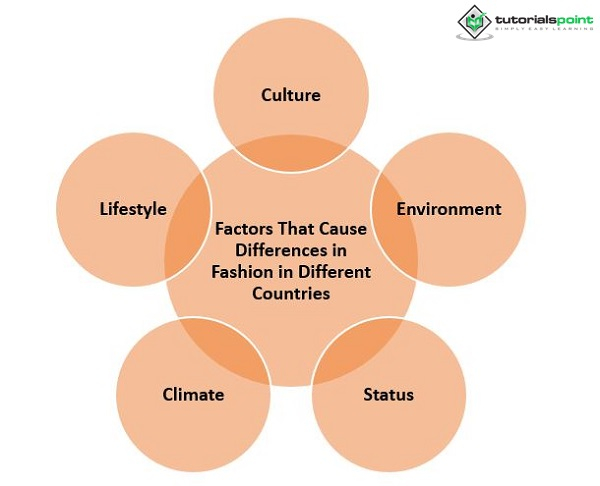

Fashion has a long history of making mistakes. What was considered fashionable a few decades ago may now be considered “killing fashion!” Similar to this, what is popular in one country would have been called fashion suicide in another. Fashion trends are greatly influenced by the time period, the beliefs of the populace, and the culture of that time period and place. A particular nation’s culture is reflected in the clothing and accessories that designers and manufacturers create. Then, it adopts the style of the area. Only if a fashion trend fits with the local culture will people follow it.

In Qatar, it’s rare to see Muslim women wearing miniskirts or American women wearing burqas. Ancient Egyptian civilization had a significant impact on its clothing. They wore attire that was not only stylish but also cosy for them in the warm weather. This is why people preferred white the most. Most of the workers and kids were naked. Rich people wore the most jewellery and clothing. Bhutanese fashion designers don’t even attempt to create anything that would be in opposition to the long-standing traditions practised in their nation.
The traditional clothing of the Bhutanese must be worn in public. Australia’s native emu bird is widespread throughout the country. Emu-feather hats are popular in Australian fashion. This hat was once used by Australian light horsemen. Australian flora and fauna also serve as inspiration for millinery. It has long been part of this nation’s culture to relate everything to its scenic and natural beauty, even fashion. Therefore, it is a fact that the environment has a significant impact on fashion in a particular country.
Of course, a region’s culture evolves with time. The shifting culture in that region has an impact on fashion trends as well. Most people learn about fashion trends via the media. They attempt to emulate the attire and personal style of their favourite celebrities, actresses, or models. Otherwise, they can copy their friends’ fashion choices and try to incorporate them into their own lives. This is how a particular trend spreads throughout an area. Even if it looks excellent, they cannot wear something wholly unconventional. Anything that a nation’s culture accepts and considers significant enough to influence becomes popular.
Major factors are −
Cultural shifts have an impact on the fashion that is developed by the inhabitants of that particular culture or location. For instance, millions of people from different cultures around the world follow distinct fashion trends. The people’s culture makes sure that clothing and fashion accessories achieve specific purposes or objectives. The choice of fabric and design is also influenced by culture. Designers can, for instance, pick from a variety of locally abundant native materials and employ them. This will foster a feeling of belonging.
The immediate environment has a significant impact on how individuals purchase and dress across various nations. The people of a country have power over environmental factors, not producers, wholesalers, distributors, or retailers in the fashion sector. Simply put, fashion is adapted due to changing socioeconomic and societal needs by going with the flow.
Our socioeconomic standing can also be expressed through our clothing. For instance, if a person works in an office, they should dress formally or in any appropriate apparel. Higher position and performance are associated with stronger propensities to violate dress codes. A luxury handbag is a typical purchase for a lot of people. For example, in New York City, people like to wear expensive and branded clothing. People who live in more elite nations with high social standing like to exaggerate their clothing, whereas people in countries that are underdeveloped or socially backwards like to dress in minimalistic fashion.

The preference for wearing clothing varies with the climate. Different regions’ residents dress differently. Our bodies are better protected from adverse weather conditions when we are dressed. In warm weather, we wear lightweight clothing; however, in cold weather, we need to wear complete shirts, sweaters, jackets, etc. To protect oneself from the rain during the rainy season, we use clothing like raincoats. For instance, cotton clothing helps us stay cool in the summer because it absorbs sweat. As a result, individuals in cold-weather countries like Canada and the US dress in wool. People in hotter nations, such as Kenya and Indonesia, dress in light cotton clothing. In light of the fact that every country has a unique climate, we can conclude that climate has an impact on global fashion.
The choices people make for their wardrobes are greatly influenced by their way of life. And as a matter of fact, different countries have different lifestyles. Clothing fulfils a variety of functions that relate to various facets of a person’s everyday life. Fashion is a way of life; your appearance, the way you wear your clothes, what you wear, when you shop, how you make purchases, and the places you go while wearing your clothes and accessories reflect your lifestyle and available funds. Fashion and lifestyle are thus tightly intertwined.
Thus, people dress according to the climate, culture, environment, and their status in their respective countries. People dress more casually in hotter regions, donning lighter cotton- or wool-based garments, while in colder regions, they dress more formally in heavier garments. Due to cultural norms, people may dress differently. While men wear turbans in some cultures, women often cover their heads with a scarf or veil. While work attire in more casual nations tends to be jeans and t-shirts, suits and ties are more frequent in Western societies. As a result, there are many reasons why people dress differently in various parts of the world, and each explanation is unique to that region’s climate and culture.